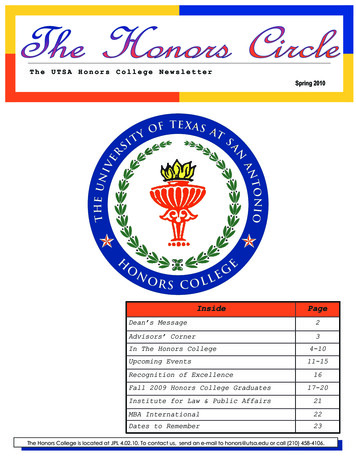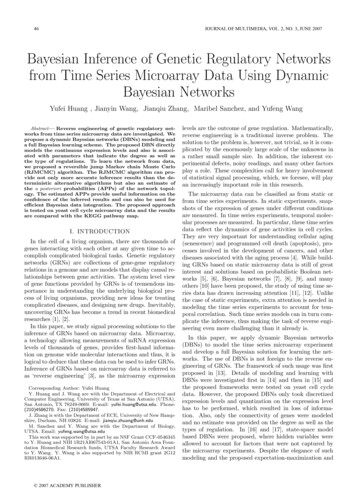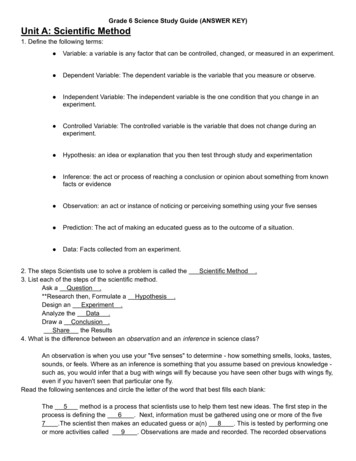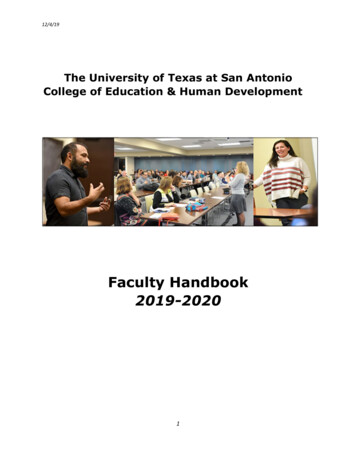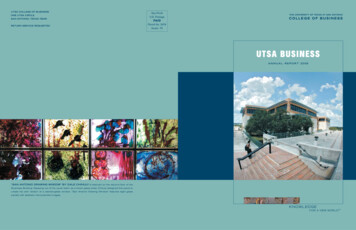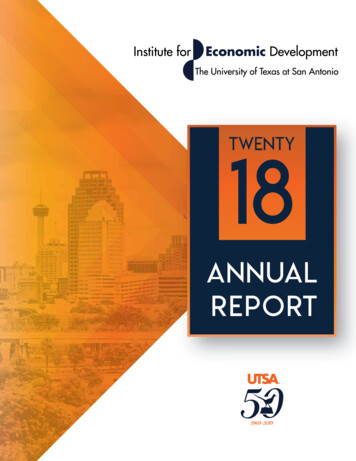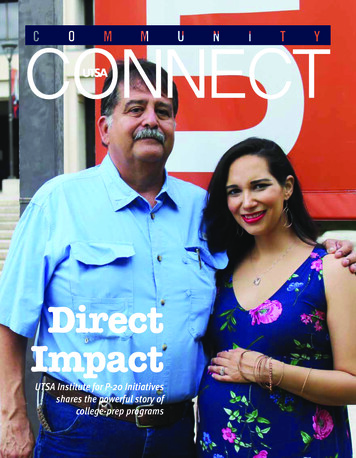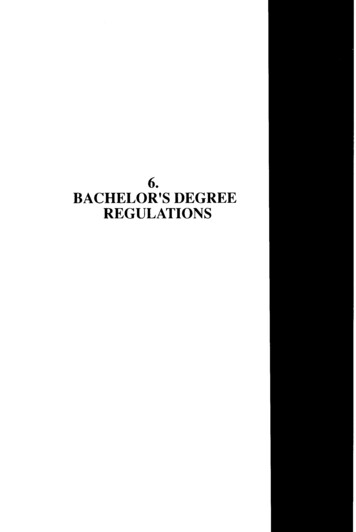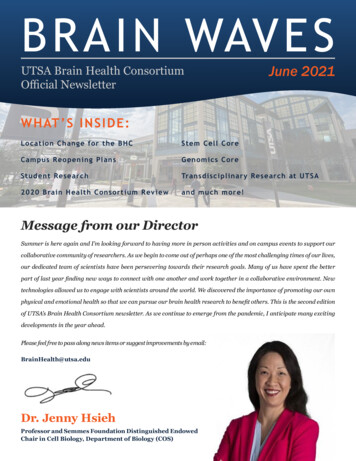
Transcription
B RAI N WAVESUTSA Brain Health ConsortiumOfficial NewsletterJune 2021W H AT ’ S INS ID E:Loc a t i o n C h a nge for th e B HCSte m Ce ll Co reC a mpu s R eo pe ni ng Pl a nsGe no mics Co reS tu d e n t R es e a r chTransdisciplinary Re se arch at U TS A2 0 2 0 B ra i n H ea l th C onsor ti um R e v ie wand much mo re !Message from our DirectorSummer is here again and I’m looking forward to having more in person activities and on campus events to support ourcollaborative community of researchers. As we begin to come out of perhaps one of the most challenging times of our lives,our dedicated team of scientists have been persevering towards their research goals. Many of us have spent the betterpart of last year finding new ways to connect with one another and work together in a collaborative environment. Newtechnologies allowed us to engage with scientists around the world. We discovered the importance of promoting our ownphysical and emotional health so that we can pursue our brain health research to benefit others. This is the second editionof UTSA’s Brain Health Consortium newsletter. As we continue to emerge from the pandemic, I anticipate many excitingdevelopments in the year ahead.Please feel free to pass along news items or suggest improvements by email:BrainHealth@utsa.eduDr. Jenny HsiehProfessor and Semmes Foundation Distinguished EndowedChair in Cell Biology, Department of Biology (COS)
WE’VE MOVED!A lo t ha s ha p p e n e d s in c e o u r last updat e, including t he co mpletion oft he ne w ho m e f o r th e B r a i n Healt h Co nso rt ium, t he S ci e n ce a ndE n g ineer ing Bu ilding (S EB).The SEB was completed in the Summer of 2020 and is currently the largest construction project in UTSAhistory. This groundbreaking building was designed with innovative and fresh ideas on how research canbe conducted to foster a more open, collaborative environment.One of the key features behind the SEB design was to bring together students, faculty, and staff from alldisciplines to advance UTSA’s Brain Health Initiative. Looking at the 4th floor that the Consortium callshome and seeing the thousands of square feet of open lab design, you can see the potential waiting to betapped in these shiny glass walls.CA M P U S R E O P E N IN G PL AN SUTSA strives to protect its community by offering the most informed and conscientious plans for actionthat can arranged based on a wide variety of informative sources. In doing so, official announcementsconcerning the details of a full return to operations have been delayed for the time being.However, Roadrunners have been assured by President Eighmy that “UTSA will be open this fall with asemester crafted for personalized, impactful student learning experiences and the safety of all Roadrunners.”Ma in it ems of inte re s t th at ar e alr e ad y be i n g put i n pl a c et o mo ve forward:UTSA’s academic calendar for this fall will not changeAn extensive set of public health safety measures are being implementedStudent Housing, Libraries, Campus Rec, and the Student Union will be availableReturn-to-work modalities are being explored for staff and facultyThe entire semester is designed to be highly adaptableFor more tiatives/campus-reopening/updates/
TRANSDISCIPLINARYRESEARCHAT UTSAStem Cells and Precision MedicineDr. Melanie Carless (COS) is focused on identifying genetic and epigenetic factors that increaserisk for complex diseases, such as mental illness. Currently, she is interested in how brain-enrichedepigenetic signatures might be modulated during neurodevelopment to impact risk for bipolardisease. She and her lab plan to identify differences in hydroxymethylation profiles between corticalspheroids derived from individuals with bipolar disorder and those without any history of mentalillness. For more information: gineeringDr. Gabriela Romero Uribe (COE) is focused on developing exclusive nanotechnologies to manipulatecellular signals and behaviors. These nanotechnologies are centered in engineering soft magneticnanomaterials for applications in wireless neuromodulation, nerve regeneration and drug delivery.For more information: . Isabel Muzzio (COS) is using tiny microscopes embedded in a mouse’s brain to evaluate neuralactivity within the hippocampus. This brain region is important for making memories and makinga map of your location. Her team hopes to understand how this part of the brain is affected inAlzheimer’s disease and during aging.For more infomration: htmlPsychology and BehaviorDr. Edward Golob (HCAP) studies two lines of research in the auditory arena. Auditory attention(particularly spatial awareness in regards to the origin of a sound) and the study of relationshipsbetween auditory perception (recognizing speech versus music). Both of these share a commontheme in how other cognitive systems (attention, memory, and perception and reaction) interactwith sensory processing in the auditory system. This research can be applied to the study andpotential therapies for neurological disorders such as Alzheimer’s and speech fluency disorderslike stuttering. For more information: http://www.golobcogneurolab.org/
S P O T LI GH T ON S T U DEN T R ESEAR C H :CO V I D- 1 9 a n d t he B ra i nCourtney McMahonMariah Antopia(Cell and Molecular Biology PhDstudent) Courtney is focused onthe effects of maternal exposuresduring pregnancy on the developingfetal brain using a unique laboratorymodel called an organoid. She hasleveraged this technique to create brain organoids to assistin a groundbreaking study that suggests COVID-19 canimpact and enter the human brain via glial cells, whichare a multifunctional set of brain cells involved in nervecommunication as well protecting the brain from infectionand chemical harm. For more on the study please see:(UTSA undergraduate) Miriah is abiology major in the ESTEEEMEDprogram conducting neurosciencere se a rch. She wa s rec ent lyawarded the Goldwater Scholarfor Research Excellence, one ofthe most prestigious national scholarships awarded toundergraduate students in research. Mariah’s researchinvolved looking at molecules that could help SARS-CoV-2infect the brain. For more information on Mariah andthe other Barry Goldwater Scholars at 2021.htmlBH C S EE D G R AN T AWAR D WIN N ER SFY2021 Faculty AwardeeDr. Matthew WanatThe role of VTA astrocyteneuron interactions in durgaddictionFY2021 Faculty AwardeeDr. Melanie CarlessHydroxymethylation Patternsof Cortical Spheroids AcrossNeurodevelopmentThe Brain Health Consortium (BHC) Collaborative Seed Grant (CSG) program,sponsored by the Office of the Vice President for Research, Economic Development,and Knowledge Enterprise (REDKE) at The University of Texas at San Antonio(UTSA), is offering seed grants to support collaborative research at UTSA.These grants support a broad range of trans-disciplinary research that may yieldfundamental insights into the mechanisms underlying brain disorders.
S PO TLI GH T Q & A: Dr. Sonal GoswamiDr. Sonal Goswami is investigating the cellular and network physiologyunderlying epilepsy in the lab of Dr. Jenny Hsieh.She is looking at the underlying causes of both acquired and genetic origins bymanipulating adult-born granule cells involved in seizure-related phenotypes anddeveloping assays to use in “disease-in-a-dish” models of genetic epilepsy. Herresearch interests include epilepsy, stem cells, and electrophysiology.Te ll us h ow y o u f i rs t g o t i n v o lv ed in bra in res ea rch?It all started in AP Psychology class, where the teacher referred to the limbic system as “the seat of emotion”.I was amazed that a collection of cells could be responsible for generating our most subjective feelings.I made sure to attend a University where I could obtain an undergraduate degree in Neuroscience andluckily found such a place near home at the University of Texas at Dallas.This is where I was first exposed to whole-cell patch-clamp techniques in Dr. Tres Thompson’s lab, wherea graduate student was recording activity from individual neurons in the hippocampus. I was amazed tosee what nerve impulses looked like and how these responses change with different types of manipulationsdone on living cells.What has su rpri s ed y o u th e mo s t a bo ut wo rkin g wit h t he brain?To understand such a complex system, you have to use an interdisciplinary approach.What w o u l d y o u tel l s o meo ne who is t hin kin g a bo ut purs uin g a r e se ar ch c ar e er?“.1% inspiration, 99% perspiration” - Thomas EdisonFUNDING IN BRAIN HEALTHRead about the Oskar Fischer Prize opportunity toexpand understanding of Alzheimer’s disease at:https://oskarfischerprize.com/Entries have been closed and are under review asof Spring 2021. Announcement of Winners comingsoon, stay tuned!
Aug 18, 20202020 IN REVIEWDr. Nicole Wicha named a Fellow in the National STEM Academy based on her innovative research, her passion for mentoring and her impact and influence on brain health research.Dr. Wicha is the director of the UTSA Laboratory for Brain, Language and Cognition and a member ofthe graduate faculty in neurobiology. She joined the faculty in 2005, adding unique interdisciplinaryexpertise in the neurobiology of human language and math cognition, with a special focus on thebilingual brain.For more information about Dr. Wicha: https://www.utsa.edu/biology/faculty/WichaLab/Nov 12, 20202 020 Fa l l N eu r o s cien ce Symp o s iumThe Brain Health Consortium’s own Dr. Lindsey Macpherson was host to an esteemed scientificpanel of researchers covering several areas of scientific interest, all come together to discuss the‘gut-brain axis’.This emerging area of study is gaining significantinterest and fundamentally changing the way wethink about connections between mind and body.The panel was incredibly informative and thoughtprovoking.Nov 30, 2020Hats off to Dr. Sandeep Vellanki, who as a graduate student in Biologysecured a Seed Grant from the Brain Health Consortium to help furtherhis studies on the link between fungal infections and neurodegenerativedisorders.Sandeep is a shining example of how interdisciplinary approaches arethe key to brain health research and innovation. He will be taking hisPhD in Cell and Molecular Biology from UTSA to continue his infectiousfungi research as a postdoctoral fellow at the prestigious Geisel School ofMedicine at Dartmouth College.
UTSA: STEM CELL COREWHAT WE DODerivation of iPSCs from skin and blood samples.Reprogramming using episomal vectors or Sendai virus expressing OCT4, SOX2, KLF4,and c-MYC.Customized projects including differentiation protocols, organoid generation and CRISPR/Cas9-based gene editing.Access to a streamlined, IRB-approved consenting process for acquisition of patient samplesand phlebotomy services.Contact UsThe University of Texasat San AntonioOne UTSA CircleSan Antonio, TX 78249Phone:210.458.6497Wolf Cytometer andN1 Single Cell DispenserThe Wolf cytometer and N1 single cell dispenser uses low pressuremicrofluidic sorting allowing sensitive cells to be sorted in theirnative media and the low pressure helps to assure their viability.The Wolf cytometer is able to detect 3 fluorescent colors simultaneouslyalong with back and forward scatter. In addition to bulk sorting theN1 single cell dispenser allows for as little as one cell to be platedinto each well of a 96 or 384 well lthCyBio FeliXThe CyBio FeliX is a flexible, programmable pipetting liquid handlingstation. The FeliX is housed in a Biosafety cabinet for use with BSL2 samples.In the current configuration it can pipette 96 wells simultaneouslybut can also pipette from 1-8 wells at a time expanding the flexibilityand it can pipette from and into 24, 96 and 384 well plates. It has 12deck positions allowing for complex experimental design or multipleplate feeding.
UTSA: GENOMICS COREC O NTA C T U SWHAT WE DOOne UTSA CircleBSE 3.108Prepare and sequence DNA libraries for Next Generation Sequencing (NGS)applications.San Antonio, TX 78249Phone:Process whole genomes, transcriptomes, epigenomes and more.Expertise in bacterial genome assembly and mammalian singe-cell genomics.Provide cutting edge technology and services to maximize successful W COURSES FOR FALL 2021!Space and Time in the Brai n (Un de r g rad s an d G rad uat es )G r ad ua t e sBI OL 6 9 7 3CRN: 17749 Fall 2021T 4:00- 5:15pmOnlineUn de r g r a d s.BI OL 4 9 5 3CRN: 19829 Fall 2021T 4:00- 5:15pmOnlineWhen you navigate a familiar environment, you don’t need a map because the map is already in your brain. But where inthe brain? And how can networks of neurons conjure up a map of your surroundings? This course covers what we currentlyknow about these questions from animal and human studies. You will learn about place cells, grid cells, and other spatialcells found within and beyond the hippocampal formation.Recently, scientists have observed that these cells also appear to signal the passage of time, suggesting that the brain usescommon mechanisms to process space and time while forming memories.B I O L 4953- Brain Dise a sesCRN: 19830A study of selected major brain diseases and neurological disorders,their underlying causes and treatments, with an emphasis on molecularFall 2021mechanisms.MW 10:00- 11:15 amSc h e d u l e d TopicsMain CampusDown syndrome, Fragile X syndrome, ADHD, Autism spectrum disorders, Schizophrenia,Anxiety, Depression, Prion diseases, Alzheimer’s diseases, Parkinson’s disease, and many more.
SPECIAL THANKS TO OUR BHC DONORS:Ba p t i st He a lt h Fou ndation of S an AntonioThe B r own f ou ndationThe Lowe Fou ndationThe M a x a n d M i n nie Tomer lin Voelc ker Fu ndThe M i ndf u ll Fou ndationThe P e r ry & R u by Stev ens C har itable Fou ndationRob e r J . Kl e b e r g , J r . and Helen C . Kleber g Fou ndationSe m m es Fou ndationCONTACT US!BHC Operations Manager: Gregory GranadosMedia Specialist: Adrian MartinezWebsite: utsa.edu/bhc/Twitter: @UTSABrainHealthEmail: BrainHealth@utsa.eduPhone: (210) 458-7024Fax: (210) 458-4061
soon, stay tuned! FUNDING IN BRAIN HEALTH. 2020 IN REVIEW Aug 18, 2020 Dr. Nicole Wicha named a Fellow in the National STEM Academy based on her innovative re- . into each well of a 96 o
